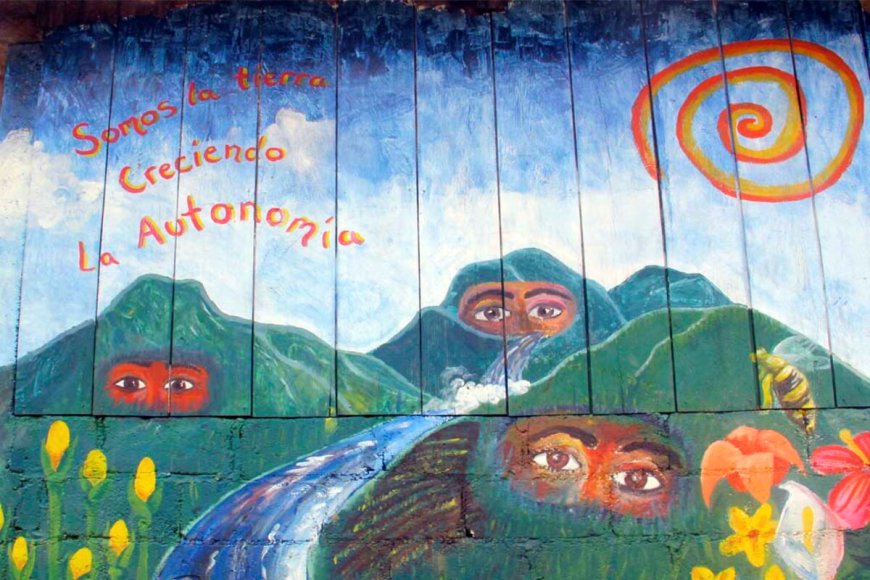Are Autonomous Politics at an Impasse?
Analysis of the state of autonomous politics in so-called Mexico. Are autonomous politics at an impasse in Mexico? That depends on where you look for them, and what you understand by autonomy. Over thirty years of community organization and political resistance articulated around a discourse of autonomy has led to the corralling of autonomous politics... Read Full Article

Analysis of the state of autonomous politics in so-called Mexico.
Are autonomous politics at an impasse in Mexico? That depends on where you look for them, and what you understand by autonomy. Over thirty years of community organization and political resistance articulated around a discourse of autonomy has led to the corralling of autonomous politics into the legislative and legal framework of the Mexican state—not to mention the politics of human rights organizations, NGOs, and international institutions—which in turn has shaped the practice of autonomous politics on the ground and in the communities.
Let’s look at two different conceptions of autonomy. Firstly, autonomous politics as a practice of self-organization, self-management, and self-determination; something embodied in everyday life, derived from below and from within. A lively expression of social organization, always in movement, rooted but spontaneous. Autonomous politics as something plural—autonomies—defined and developed according to each struggle in its context. Autonomy as a means of struggle, prefiguration, direct action.
Let’s look at another conception. Autonomy as a right to be recognized and enforced by the state. Autonomy mapped, defined, and dictated by state legislation. Autonomy as a demand made to the state. The demand for the right to autonomy; the demand for respect for autonomy; even the demand for the right to defend the right to autonomy. Autonomous politics molded through the bureaucracy, legal and judicial mechanisms of the state.
The historical development of the Zapatista movement in Chiapas embodies these two different conceptions of autonomy. The days following the uprising on January 1, 1994, the rebellion was met with brute state force. After 12 days of fighting a ceasefire was reached and dialogues were agreed upon between the Indigenous rebels and the Mexican state. These dialogues eventually developed into the signing of what are known as the San Andres Accords.
In 2001 Congress passed a watered-down version of the San Andres Accords, which the Zapatistas rejected outright. As a response, the Zapatistas broke off dialogue with the Mexican government. The break-down of dialogues led the Zapatistas from engaging autonomy as a demand to the state and a form of legal recognition, to organizing and constructing autonomy in practice in their territories and communities. The break-down of the dialogues with the state might have been the key to the Zapatistas’ success.
Yet, beyond the Zapatista movement, the state seems to have found recognition politics as a means to reduce the free autonomous activity of Indigenous communities and movements. The federal government, along with different state governments, have passed legislation recognizing in different ways Indigenous autonomy, yet that autonomy is always subdued to the sovereign authority of the Mexican nation-state. Meanwhile, the plunder of Indigenous territories, the assassination and incarceration of Indigenous land defenders, and the multiple forms of dispossession against Indigenous communities continue with voracious force.
Rather than producing the conditions for freedom, autonomy as a right to be recognized by the state seems to be leading community movements and struggles into a dead end. The effects are demobilization and the exclusion of other tactics and forms of organization that might defy, subvert, or threaten legal pathways demanded by the state. It is also leading movements to “perform the state” as Audra Simpson puts it, molding their practices beforehand to fit the structures and discourses of state recognition.
At the same time, NGO’s, human rights organizations, and other “non-state” actors serve a similar purpose reproducing the state by restricting the self-determination of community movements. Whenever a struggle erupts somewhere, these organizations quickly appear with lawyers, how-to manuals, and pre-determined pathways of political resistance. The community’s struggle then follows a guide rather than developing in a self-determined manner. The strategies and politics of these organizations often serve the interests (and bank accounts) of the organizations more so than the community’s struggle for self-determination and autonomy.
To return to the question at hand: are autonomous politics at an impasse in Mexico? In some ways the answer is obvious. If impasse means a dead-end, a space without an exit, and if we understand autonomous politics to mean free self-organization, self-management, and self-determination, then autonomous politics will never be at an impasse. Expressions of autonomy are always present in the everyday life activity of neighborhoods and communities, in collective work and communal lands, in forms of mutual aid and community reproduction. This free activity makes an impasse impossible.
On the other hand, if autonomy becomes further articulated into the language, constraints, and processes of the state and its bureaucracy, then it’s likely that these movements and forms of organization will be further alienated from their capacity for self-organization, further corralled into the legal, judicial, and bureaucratic geographies of the state, further strangling their spontaneity and self-determination.
We might say that at an impasse is where the state wants autonomous politics. Stuck in dialogue, reduced to permitted pathways and forms of life, unable to advance or escape, enclosed in a dead-end. The task at hand seems to be that we strengthen and expand those other expressions of autonomy, where communities decide their futures freely, collectively, in practice, in movement.
What's Your Reaction?
























